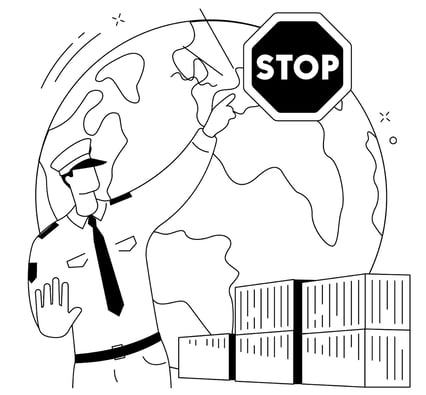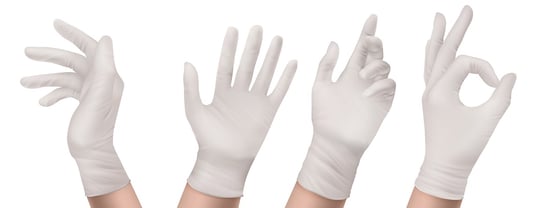Cleanroom gloves are supposed to be contaminant free. But not all gloves meet that requirement – and the impact on your controlled environment and yields can be enormous. Glove formulas can introduce hidden contaminants.
[Part 2 in our Risk Reduction: Glove Contamination Series]
Table of Content
- 3 Questions
- Does your manufacturer inspect, audit, and monitor?
- Complacency puts yields at risk
- Regular review of specifications prevents catastrophic loss
Here are three qualifying questions to ask your supplier now, next year, and every year to reduce the risk of contaminants introduced by glove materials:
Question 1. Are their cleanroom gloves washed offline after manufacturing using a double chlorination process to remove particles from both the inside and outside of the gloves?
Answer: Double chlorination removes particles and residuals from the inside and outside surfaces of the gloves after the manufacturing process. Gloves are made by dipping hand-link forms (formers) in the substrate material until the correct thickness is achieved.
The gloves are then rinsed and cured while still on the formers. In the first step of the double chlorination process, gloves are washed in a chlorine solution to remove particulates and ionic residues left on the glove from manufacturing and to reduce tackiness (or stickiness). This first step is online chlorination. If this is the only step, it’s just single chlorination. Powder-free boxed gloves used for non-cleanroom, PPE applications are typically single-chlorinated.
The second step of double chlorination is to remove the gloves from the formers and invert them to wash the side of the glove that was in contact with the former. This process removes gross contaminants from the manufacturing process. This second step is offline chlorination and is crucial for cleanroom gloves used in critical applications.
After the double chlorination process, the gloves should be processed through multiple deionized (DI) water rinse cycles to further remove excess particulates, extractable ions, and nonvolatile residues.
Question 2. What testing methods do they use to detect upper and lower limits of particles and extractables to publish specifications and issue Certificates of Compliance?
Answer: First, the manufacturer should follow independent, repeatable testing standards such as IEST or ASTM practices. Proprietary, undisclosed, or inconsistent testing “standards” are untrustworthy. Depending on the manufacturer’s glove specifications, there are several types of standardized glove cleanliness tests including:
- Liquid particle count (LPC) tests measure particles released in liquid after predefined mechanical agitation. These extracted particles, also known as extractables, are then tested for chemical composition using high-performance liquid chromatography (HPLC). Together, LPC and HPLC quantify particles and characterize extractables.
- Scanning electron microscopy (SEM) more precisely detects and characterizes glove defects and the chemical composition of extractables.
LPC, HPLC, and SEM are examples of good, better, best testing technologies – the higher the cleanliness specifications, the more rigorous test is required to validate performance and certify compliance to specifications.
Air particle count (APC) tests measure particles released from the glove after manual or mechanical agitation. With new and better testing methods with fewer variables, APC is no longer a best-practice testing method. Manual APCs, such as old-fashioned clap tests, are not uniform, repeatable, or reliable.
Download Now: Cleanroom Glove Selection Guide
Question 3. What percentage of their business is cleanroom gloves?
Answer: This business information may not be forthcoming from a manufacturer but investigating this will provide you with insight into the importance of cleanroom gloves to their business – an indicator of their technical acumen and commitment to glove quality, cleanliness, testing protocols, and performance.
Remember that most gloves manufactured globally are not for cleanroom application and it’s valuable for you to know how dedicated your supplier is to manufacturing “clean” gloves within their product portfolio.
Does Your Manufacturer Inspect, Audit, and Monitor?
In addition to setting rigorous glove specifications prior to manufacturing and applying IEST testing standards to our finished glove products, Valutek goes the extra mile on quality control by dedicating employees to inspect, audit and monitor our manufacturing process from start to finish.
We go even further, making available a rolling 36-month trend analysis on our finished products to detect and examine causes of variances that are within our upper and lower limits of particles and extractables.
Complacency puts yields at risk.
In the cleanroom consumables industry, glove construction evolves with more demanding applications and the development of advanced materials. Testing methods improve with experience and advances in technology.
In this dynamic environment, when was the last time your organization asked your manufacturer for a Certificate of Compliance, and what their testing protocols are to support that? It’s important to ensure your glove requirements and the manufacturer’s current documentation are reviewed at least annually.
Regular review of specifications prevents catastrophic loss.
Cleanroom gloves come into more direct contact with products, equipment, and tools than any other cleanroom consumable, posing a high risk to yields and profitability if the gloves introduce contaminants to your controlled environment. The risk can be minimized if your cleanroom glove manufacturer is forthcoming in providing Certificates of Compliance and is transparent in providing the uniform, standardized testing practices they follow.
Your organization can be proactive to request and review current product documentation regularly to identify any incremental differences between your requirements and the manufacturer’s specifications before any variability impacts your critical process.
Here are some additional resources you might find useful about cleanroom gloves and related topics:
- Video: Watch How Cleanroom Nitrile Gloves are Made
- Video: IEST Asks the Experts: PPE and Future Supply Risk Mitigation
- IEST Recommended Practices RP-CC005: Gloves and Finger Cots Used in Cleanrooms and Other Controlled Environments

Valutek
Valutek is one of the first and few manufacturers to offer a full product portfolio of best-in-class cleanroom products. Since 1988, our controlled environment consumables are helping leading organizations operate their cleanrooms in a consistently stable state.
Related Articles
- Valutek

- 20 February 2023
Import Bans: How Unethical Labor Practices Impact Business Continuity
Global supply chain disruptions caused by the COVID pandemic led to bad actors in markets, as well...
- Valutek

- 27 December 2023
Glove Liners: Improving More Than Operator Comfort
Operators in your controlled environment know it—cleanroom gloves can be uncomfortable, reduce...
- Valutek

- 21 February 2023
Cleanroom Glove Selection Fundamentals - Part I : What You Need to Know
Selecting the most appropriate cleanroom glove can seem complicated. If you are trying to match...


